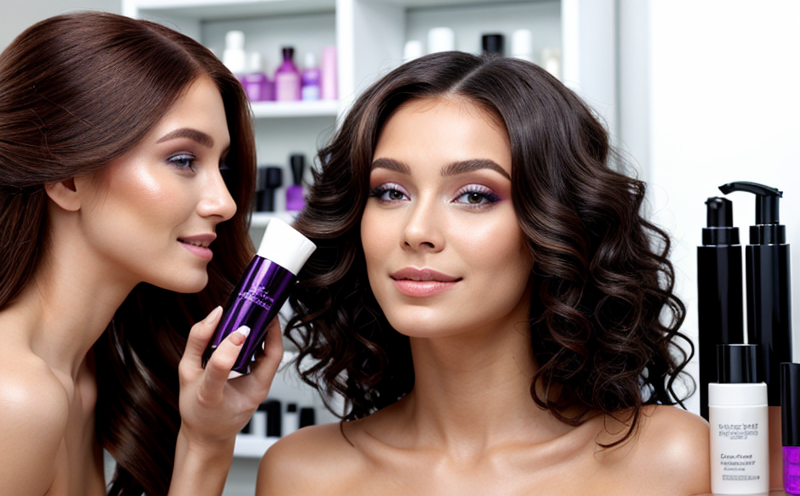Color Protection Testing in Hair Shampoos
The importance of color protection testing in hair shampoos cannot be overstated. As consumers increasingly demand products that maintain the integrity and vibrancy of their hair colors, manufacturers must ensure their formulations are robust enough to withstand environmental stressors such as UV radiation, chlorine, and other aggressive elements. This service involves a series of rigorous tests designed to evaluate how well a shampoo can protect colored hair from fading or losing its color intensity.
Color protection testing typically encompasses several key parameters including resistance against UV light, chlorine, saltwater, and peroxide bleaching agents. These tests help manufacturers identify potential weaknesses in their product formulations early on, allowing for necessary adjustments to improve performance. The goal is not only to enhance consumer satisfaction but also to extend the shelf life of colored hair by prolonging its appearance as close as possible to its original state.
One crucial aspect of this testing process involves using advanced spectrophotometric techniques to measure changes in hair color over time under various conditions. This allows for precise quantification of color alteration, which can then be correlated back to specific ingredients or formulation adjustments. Additionally, rheological analysis may play a role in understanding how different shampoos behave during application and rinse-off phases.
Another important factor is the selection of appropriate test methods that align with international standards such as ISO 10309-2 for measuring color permanence after exposure to artificial sunlight or ASTM D7586 for evaluating the effect of oxidative bleaching agents on colored hair. Compliance with these guidelines ensures consistency across brands and regions while providing consumers with reliable information about product performance.
Manufacturers must also consider factors like pH balance, surfactant type, and preservative systems when designing color-protective shampoos. Each component can influence the overall stability of the final product and its ability to maintain hair color over extended periods. By carefully selecting these ingredients based on extensive research and testing, companies can create effective solutions that meet both regulatory requirements and consumer expectations.
The process begins with thorough formulation development followed by preliminary lab trials aimed at identifying promising candidates. Once a base formula has been established, further refinement occurs through iterative cycles of ingredient optimization and quality assurance checks. Throughout this phase, continuous evaluation using state-of-the-art analytical tools is essential to ensure that every batch meets stringent standards for efficacy and safety.
As the industry continues evolving towards more sustainable practices, it becomes increasingly important for companies to adopt eco-friendly alternatives whenever possible without compromising on performance or effectiveness. For instance, incorporating natural extracts known for their antioxidant properties could provide additional benefits beyond just color protection. Such innovations reflect a broader trend in cosmetics towards greener manufacturing processes and ingredient sourcing.
In conclusion, color protection testing is an indispensable tool in the development of high-quality hair care products that deliver lasting results while maintaining environmental responsibility. By leveraging cutting-edge technology and adhering strictly to relevant standards, laboratories like Eurolab can offer unparalleled expertise in this specialized field, ensuring that every product meets or exceeds customer expectations.
Why It Matters
The significance of color protection testing extends far beyond mere aesthetics; it plays a vital role in enhancing user experience and satisfaction. When consumers invest time and money into coloring their hair, they expect those efforts to last as long as possible without noticeable fading or dulling. A well-protected color not only looks more attractive but also maintains its integrity longer, which translates directly into higher customer loyalty.
Moreover, from a business perspective, ensuring robust color protection can lead to increased sales and reduced returns due to unsatisfactory results. Companies that consistently deliver products meeting or exceeding industry benchmarks are more likely to build strong reputations and foster long-term relationships with their customers. This competitive advantage can translate into significant market share gains over time.
Environmental considerations also come into play, particularly in light of growing consumer awareness regarding sustainability practices within the beauty sector. Products perceived as environmentally friendly tend to resonate better with eco-conscious consumers who prefer brands committed to reducing waste and minimizing harmful impacts on ecosystems. Incorporating color protection measures that align with these values can help companies appeal to broader markets while contributing positively to societal goals.
Lastly, regulatory compliance remains a critical factor in this area. Many countries have specific regulations governing the labeling of cosmetic products containing artificial colors or permanent hair dyes. Ensuring that all claims made about color protection are accurate and verifiable according to these rules helps prevent legal issues and maintains trust between brand owners and regulatory bodies.
Eurolab Advantages
At Eurolab, we pride ourselves on offering comprehensive services tailored specifically for the cosmetic industry. Our expertise in color protection testing is rooted in years of experience working closely with leading brands across the globe. With state-of-the-art facilities equipped with cutting-edge instrumentation and highly skilled professionals, we provide unparalleled accuracy and reliability.
Our team comprises chemists, physicists, and engineers specializing in various facets of hair care science. They bring diverse backgrounds to bear on each project, ensuring that no detail is overlooked during the testing process. Whether it's evaluating resistance against UV radiation or assessing recovery after exposure to chlorine, our experts employ a holistic approach that considers all relevant factors.
One key advantage lies in our commitment to staying updated with the latest advancements in analytical techniques and methodologies. By continuously investing in research and development, we ensure that our laboratory remains at the forefront of innovation within this rapidly changing field. This proactive stance allows us to offer前瞻





